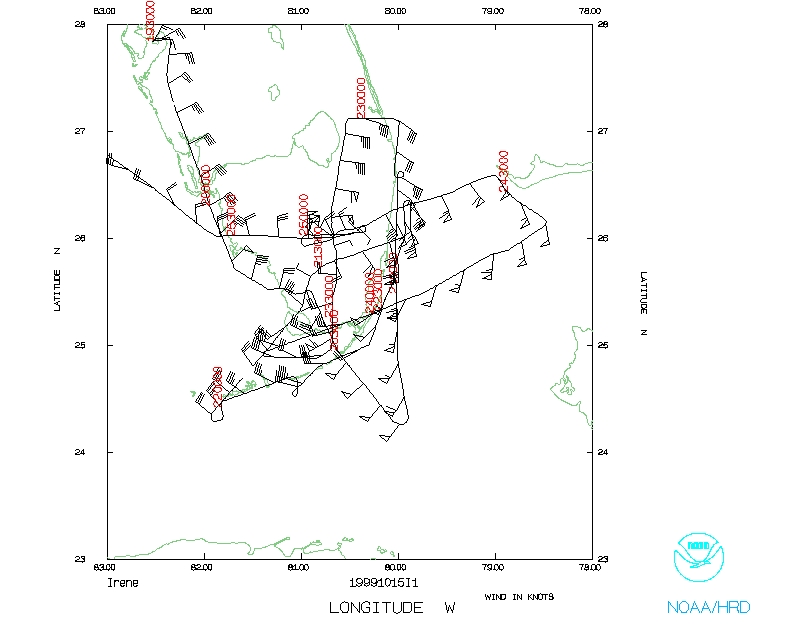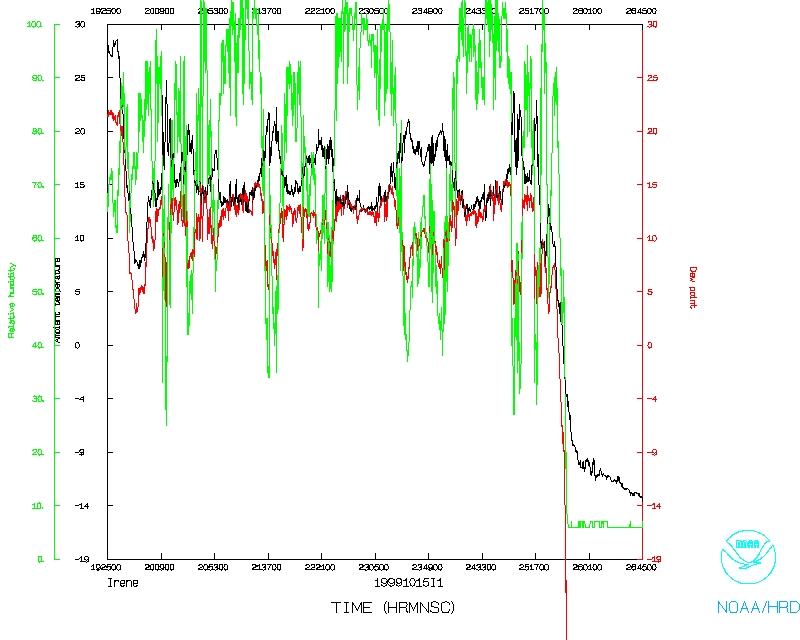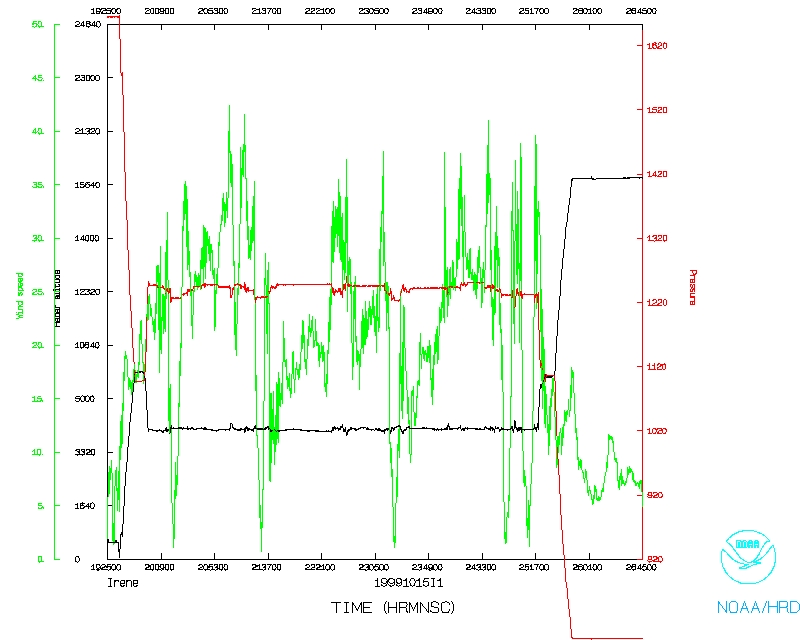 Flight track |
 Temperature and Moisture |
 Wind and Atlitude |
| Scientific Crew | Aircraft Crew | ||
| Chief Scientist | Peter Dodge, Mike Black | Cockpit | LCDR Brian Taggert, CDR Phil Kenul, Greg Bast, Steve Wade,Dewie Floyd |
| Doppler Scientist | Mike Black | Navigator | LT Carl Newman |
| Dropsonde Scientist | Mike Black, Joe Cione | Flight Director | Jack Parrish |
| Workstation | Mike Black, Joe Cione | Engineers | Sean McMillan, Jorge Delgado,LT Phill Hall |
| AXBT scientist | Joe Cione | ||
| SRA scientist | Ed Walsh | Observer | ADM Evelyn Fields |
Mission Briefing
After the NOAA P3 reconnaissance flight on 14 October 1999, it
was apparent that Hurricane Irene would hit Florida. Although
the model runs on the 14th predicted landfall near Naples, by
noon it was clear that Irene would have an impact on Florida Bay,
and the Keys and the east coast of South Florida might experience
tropical storm force winds. Frank Marks, Pete Black and Sam Houston
designed a flight track to measure waves, storm surge and winds. An
initial figure 4 through Irene was to be followed by runs along the
Keys and the coast. If possible we would fly over the land as the
storm moved North up the center of the state, over the Everglades.
The goals were to collect more wave and storm-surge data with Ed
Walsh's Scanning Radar Altimeter (SRA), and to collect GPS sonde
data near the C-MAN and other surface stations to improve real-time
and post-storm surface wind field analyses. The pattern was designed
to take advantage of the the Miami (KAMX) and Key West (KBYX)
WSR-88D radar data, and Step Frequency Microwave Radiometer
(SFMR) surface wind estimates would be transmitted back to the
Tropical Prediction Center in addtion to the flight level data.
8000' was selected as the flight level to reduce the SRA
footprint and to provide flight-level winds suitable for
reduction to 1 Om for the real-time surface wind analyses; the
Air Force would be at 5,000'.
By 1730 UTC the center of Irene was only 40 km SW of Cape Sable, so we modified the pattern for the briefing. Jack Parrish agreed that after our intial pass through the storm, followed by a leg north to Fowey Rocks, that if it looked safe we could do the second leg on a SW pass over land. He and the flight crew also agreed that 8,000' would be a good altitude for the flight. Because tropical storm force winds were still expected at MacDill AFB, NOAA 43 would recover in Gulfport, Mississippi after the mission.
Mission Synopsis
| Take off | Landing
| MacDill AFB, FL | 19:34 UTC
| Gulfport, MS | 01:31 UTC
| | ||
NOAA 43 left MacDill Air Force Base at 1934 UTC, and descended to the 8,000'flight level at 1953. Figure 1 shows the flight track. The first sonde and BT were dropped at 2009, south of Cape Romano. Jack fixed the center at 2030 UTC. We proceeded SE over Florida Bay, where we dropped a sonde and the second AXBT,and then to a point 150 km SSE of KAMX, and then turned to head north. At Fowey Rocks Light (FWYF1) we dropped the third AXBT and a sonde. At 2105 we passed through a strong rainband with 80 kt winds at flight level, near Hollywood, and then turned back south. Conditions seemed to be OK over land, so we then headed SW, passing near Opa Locka and Miami International airports before fixing the center again at 2131, where we also dropped the seventh sonde. We concluded the initial figure 4 with a leg to KBYX. At 2138 we experienced some good bumps in the clear air over the Ten Thousand Islands region. The vertical velocity calculation on the data system was bad briefly, and the SRA went down when Ed's foot hit the wave guide switch as we bounced around.
The SRA was up again at 2158 and we turned at 2200 south of Key West and then dropped the ninth sonde near SANF1. The aircraft then flew up along the keys, deploying sondes and AXBT's at the C-MAN sites. At 2224 we could see waves breaking on the reef line between Long Key (LONF1) and Molasses Reef. The flight continued along the coast. After dropping sondes near FWYF1 and in the wind max near Pompano Beach, we launched the 15th sonde at the Lake Worth Pier (LKWF1), conitinued north to Hobe Sound, turned west and then at 2303 we turned south at Indiantown, just east of Lake Okeechobee, to make our third pass through the storm. This track was Mike Black's excellent suggestion, to map more of the overland wind field. Flight level winds in the northern eye wall were only 48 kts. Jack fixed the center at 2320. The first three fixes had Irene moving 35° at 9 kts. Once again we bounced around in the clear air south of the center. At 2328 a drop was deployed in this region (#16), but it had no winds. We tracked west and deployed an AXBT (#6) north of Big Pine Key at 2345.
The last part of the flight was designed to examine the
rainbands over the Gulf Stream. Our NE track took us near the
Flamingo tower and then over Homestead. At 0023 we turned SE of
Grand Bahama Island after crossing a rainband where
two sondes were dropped, only one of which had winds (#19),
and headed for SPGF1, where
the 20th sonde was dropped at 0032. The pilots reported
St. Elmo's fire at 0015, but I could not see it. We turned and
headed WSW for our last pass through the storm. A
sonde and
AXBT were launched at 0037
over the Gulf Stream, but no winds were recorded by
the sonde. At 0043
Mike Black noted that the east eyewall was over Miami Beach.
Figure 2, a lower fuselage radar
composite for 0050, shows the strong rainbands over the ocean
and the weaker reflectivitly in the SW eyewall. Jack made his
4th fix of the evening
at 0052, putting the center west of Davie and just south of
Alligator Alley. The data system froze briefly.
The 23rd sonde drop,
in the western wind max had no winds, so at Mike's urging, we
reversed course to try to get a good sonde in this region.
The 24th sonde at
0105 also had no winds. Jack took us into the center for a
5th fix, because he did
not think the 4th was that good becuase of the data syetm
problem. At 0109 he found the center over Davie and in the
relative calm Jorge Delgado was able to dig out some sondes
from a new box underneath the luggage.
The 26th sonde was
dropped at 0116 in the west eyewall and it had good winds.
At 0118 the plane climbed to 3250 m for a s moother ride,
and we dropped our
final sonde just offshore of Marco Island at 0131,
turned, climbed and headed for Gulfport, Mississippi,
where we landed at 0311, 16 October.
Evaluation
The flight went well, perhaps a bit bumpier than folks in the
back of the plane would have liked. The sonde data will be
helpful in describing the structure of a strong tropical
storm/weak hurricane as it moves across land. There were no
hurricane-force surface winds in the
sonde data (see Figure 3),
even though some of the sondes were dropped in regions where
flight-level winds were > 75 kts. Mike Black and Joe Cione
both have mentioned the rapid drop-off in winds with altitude
in the sonde data. The thermodynamic data from the sondes,
especially those dropped over the Everglades, will help specify
the stability profiles which may help explain why the higher
winds could not mix down to the surface, except in occasional
gusts. Careful analysis of the Dopppler radar data may provide
details of the three- dimensional windfield to complement the
sonde measurements.
Acknowledgements
Jack Parrish, Carl Newman and the flight crew agreed to every
change in the flight pattern that we requested (there were
many). Sean MacMillan kept the radar running, and Jorge Delgado
managed to work with our evolving plans for
GPS sonde drops, despite the rough ride that evening.
Sam Houston, Frank Marks and Pete Black made the initial
flight tracks, and Jack Parrish assisted in sketching out the
flight track for the briefing. Mike Black suggested several
usseful modifications and additions to the track during the
flight, especial ly the N-S pass from Lake Okeechobee down to
Flamingo Key. Mike called
the sonde drops in rainbands and wind maxima. Joe Cione kept
track of the AXBT data. Tim Crum, OSF, and Victor Murphy,
Southern Region of the NWS, alerted the WSR-88D sites about our
experiment. The Southern Region of the NWS also archived the 1
minute ASOS data. At TPC Colin McAdie archived the Level IV
products from the KAMX and KBYX WSR-88D radars, and arranged
copying the KAMX Level il data tapes after the storm.
Problems
Only 20 of 26 GPS sondes launched had winds. Unfortunately some
of the sonde wind failures were in higher wind regions of the
storm. Jorge Delgado thinks that one of the boxes of sondes was
from a bad batch. The reflecivity on the tail radar seemed low,
perhaps 10-20 dBZ lower than the lower fuselage radar. This has
been a problem on NOAA 43 throughout the 1999 season. The
Doppler data appear OK.
The SFMR winds seemed too high in some regions of the storm.
In some cases this may be caused by RFI, according to Eric
Uhlhom, but Mike Black will be using this data set to investigate
whether or not there are some systematic biases in the SFMR winds.
Peter Dodge, Mike Black
Oct. 20, 1999
Mission Data:
 Flight track |
 Temperature and Moisture |
 Wind and Atlitude |